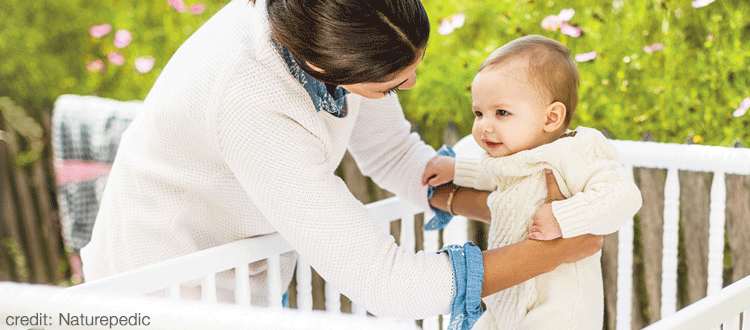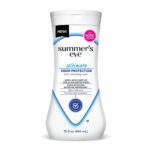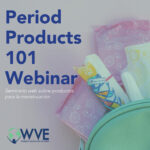Selecting a Crib Mattress: Embrace the Precautionary Principle
I want my children to be safe. I’d like irrefutable evidence on what chemicals are dangerous. I want it to be easy. The truth is, though, we live in a chemical world and have barely scratched the surface to understanding how chemicals affect us, let alone how the hundreds, even thousands, of chemicals we are exposed to daily interact in our bodies. Available research doesn’t necessarily help.
A Columbia University study found a connection between pregnant mothers who were exposed to high levels of phthalates (more about those in a bit) and asthma in their children. I’ve read studies finding links between chemical flame retardants and hormonal disruptions leading to possible reproductive and developmental problems. Each study examines a small piece of the whole in a defined setting. Causal relationships are tricky to prove, and there often is wiggle room for counter arguments. I react in a human way, by feeling scared and confused. Little is clear cut.
Stepping back and taking a deep breath (while releasing fears of indoor air quality!), the best thing I can do for my children, and myself, is to embrace the precautionary principle. In other words, make peace with knowing I won’t always get the black and white answers I want, but that if I can avoid chemicals that might be (and likely are) harmful, I’m ahead.
Look, put two tomatoes in front of me, one sprayed with synthetic pesticides and one not, and I’ll pick the pesticide-free option. Who wouldn’t? (Except someone who hates tomatoes and just walks away.) Crib mattresses are similar. It makes sense to pick one without questionable chemicals.
So what to question? The two biggest areas of concern in crib mattresses facing parents right now revolve around flame retardant chemicals, as well as waterproofing chemicals.
Flame Retardant Chemicals
Flame retardant (FR) chemicals have been linked to a laundry list of concerns from reproductive issues to attention problems to cancer. There is no federal law requiring disclosure of their use, and there is inadequate research proving exactly how they affect a developing body.
If a children’s mattress is made with polyurethane foam, a highly flammable material, it probably uses FRs to pass flammability standards. If looking to avoid FRs, watch for “flame barriers” which are often synthetic fabrics with toxic flame retardants mixed into the fabric itself. In a weird twist of PR, companies can legally claim “no flame retardants added” IF the chemicals are built into the fabric. The logic goes that they didn’t “add” the chemicals because they were already there. You’ve got to love loop holes. Actually, you don’t.
Waterproofing
Mattress hygiene for babies is essential to prevent bacterial and mold growth, so a non-waterproof crib mattress is not recommended. Ultimately it’s about keeping baby safe. You should ask, though, how the mattress is waterproofed. Topical waterproofing treatments generally contain Perfluorinated Compounds (PFCs), chemicals linked to hormonal disruption in animals and suspected in human endocrine problems. Because these persistent chemicals remain in the body (and in nature) for a long time, there are legitimate reasons to be concerned.
Another popular waterproofing method for crib mattresses is vinyl. Phthalates (I said I’d get back to these) are chemicals that turn hard PVC into soft vinyl, and they are notorious for migrating from the plastic into the environment and human bodies. These chemicals have been linked to endocrine disruption in animals, and numerous studies have drawn possible connections with human health issues.
While the toy industry often contends that scientific evidence is non-conclusive as to human risk from phthalates and that the amount of phthalates that leach from vinyl are too small to do harm (the argument is that “the dose makes the poison”), other groups, like the Center for Health, Environment and Justice, contend that that the risks posed by phthalates are simply too high and point out that emerging studies show that even exceptionally small amounts of endocrine disrupting chemicals may be dangerous. In other words, the dose might not make the poison.
While a handful of phthalates have actually been banned by the U.S. Consumer Product Safety Commission for use in children’s products, other phthalates remain allowable. A precautionary principle approach avoids vinyl and phthalates altogether in baby products.
Note, the production AND disposal of vinyl is also questionable. Made with the carcinogenic chemical vinyl chloride, vinyl can release dioxins in the air when incinerated. Dioxins have been connected to birth defects, endometriosis, diabetes, and more. Using the precautionary principle, there is enough research to justify avoiding vinyl and phthalates in crib mattresses.
How do you safely waterproof? My company, Naturepedic, uses food grade polyethylene, an inert plastic that tests well for safety, enough so that it’s used for food packaging.
Polyurethane Foam
Naturepedic has consciously decided to not use polyurethane foam. Polyurethane foam is the ubiquitous foam found in everything from couches to children’s products. The material is highly flammable, made from petrochemicals, and uses a variety of nasty inputs such as toluene diisocyanate, a possible human carcinogen.
Because I’m not an impartial scientist and work for a mattress company, I won’t demonize polyurethane foam, but suggest you do your own homework when it comes to the material and realize that a crib mattress made with polyurethane foam likely contains chemical flame retardants. Be aware that soy-foam, eco-foam, bio-foam, plant-derived foam, and other “eco” sounding names are polyurethane foam with some soy oil added. Check the mattress law label: it requires these materials be identified as polyurethane foam.
You Are in Charge
Many studies call into doubt the safety of chemical flame retardants, PFCs, and phthalates/vinyl, and some states and other countries have already placed restrictions on their use. Debates will continue to rage on between chemical manufacturers and health advocates, and studies finding health problems in a defined setting will be questioned for their broader implications. Meanwhile, little research is addressing the complicated issue of what happens when all these chemicals interact, and how low but continual exposure to these chemicals might affect a child.
Making yourself crazy won’t help, but common sense will. Keep your children away from chemicals connected to developmental and hormonal problems, including in crib mattresses on which they will spend a lot of time. Because there are few restrictions in this country regarding chemical use, you are their last line of defense. It’s up to you to take the precautionary steps.
You Can Demand Change
Want change? Ask retailers like Target, buybuyBaby, Babies-R-Us, and others to rethink crib mattresses made with questionable chemicals. Demand they carry crib mattresses made without chemical flame barriers or vinyl, even in mattresses priced at under $200 (often some of the worst offenders).
Naturepedic chooses to not use polyurethane foam because of its flammability and the toxic chemicals used in its production. While the Global Organic Textile Standard (GOTS) approves certain synthetic accessories for use in a certified organic mattress, such as polyethylene, which we use, the standard does not allow the use of any polyurethane foam under any circumstance.
A search on the Babies “R” Us website under “Natural Baby Products: Mattresses” brings up a number of mattresses containing polyurethane foam. You’ll see them listed by names like “Perfect Nature”, “Soybean Plush” and “Slumbertime Naturally.” If you wish to avoid polyurethane foam, be aware of “soy foam”, “soybean foam”, “ecofoam”, “biofoam”, or “plant-derived foam”. All these are really the same polyurethane form with some soy oil mixed in.
Also, if you see mattresses certified to CertiPUR-US, know they use polyurethane foam. The CertiPUR-US seal specifically covers only polyurethane foam, and rather than coming from an independent, third-party certifier, it comes from the polyurethane foam industry itself. You can decide if this type of certification meets your standards!
The point is, ask questions and read between the lines, even if you are looking at products listed as “Natural”. Please call Babies “R” Us at 973-617-3500 or email them at Toysrusinc.com and tell them that you want to see healthier mattresses on the store floor. Also, tell them that featuring products in a Natural section with names like “Soybean Plush”, “Perfect Nature”, “Nature Couture” and “Natural Healthy Nights”, all made with polyurethane foam, is deceptive to the consumer.
———————————
Guest post from Naturepedic — Naturepedic.com.







Thank you for the article. I am a new mother and I am so overwhelmed. Do you have suggestions of a crib mattress? I am looking into babyletto pure core with organic plush quilt cover.
This is a great resource to find out more about products and tips that are safe for babies & children:
http://healthychild.org/
Lullaby Earth is a safer mattress. http://www.toysrus.com/buy/crib-toddler/lullaby-earth-super-lightweight-crib-mattress-le10-19275876
http://www.buybuybaby.com/store/product/lullaby-earth-super-lightweight-baby-crib-toddler-mattress/1040063843
As are the varieties that Naturepedic offers.
http://www.buybuybaby.com/store/brand/naturepedic/
http://www.naturepedic.com/our-products/baby
Or, seek out something that is GOTS verified.
Tiffany, I’m the author and work for Naturepedic, so it’s probably not surprising I will recommend us. I’m not comfortable talking about other brands given my affiliation with Naturepedic,, but I will tell you what we do. Our entire mattresses are certified organic (meaning we don’t just certify pieces parts but the whole thing) and are made without questionable chemicals: no chemical flame retardants, phthalates, PFCs, antibacterial agents, etc. Mattresses are GREENGUARD Gold and Formaldehyde free certified and are also MADE SAFE (http://madesafe.org/ ) certified, which looks at the overall use of safer materials. We have a sister company, Lullaby Earth, that makes non-organic crib mattresses but ones also made without questionable chemicals and made to exacting standards. I can vouch for our products as I literally work in the same building as the manufacturing facility. I’ll leave it up to others out there to discuss competitor products!
Fantastic info. I definitely agree with the organic mattress choice.
One of my favorite: http://babycomfortauthority.com/naturepedic-organic-cotton-crib-mattress-review/
Hi Great read…thank you for all of the helpful information…. i am a mother of 3 months old baby boy.. this really helps me a lot…. thanks for sharing..